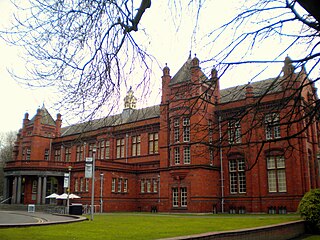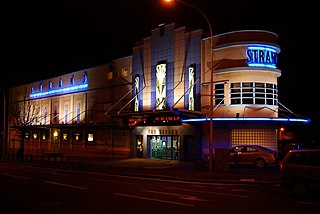
The Barber Institute of Fine Arts is an art gallery and concert hall in Birmingham, England. It is situated in purpose-built premises on the campus of the University of Birmingham.

The Whitworth is an art gallery in Manchester, England, containing over 60,000 items in its collection. The gallery is located in Whitworth Park and is part of the University of Manchester.
Richard Murphy OBE is a British architect and businessman. He is the founder and principal architect of Richard Murphy Architects, an architectural firm operating in Edinburgh. He is a winner of the 2016 RIBA House of the year.

The Royal Scottish Academy (RSA) is the country’s national academy of art. It promotes contemporary Scottish art.
The Royal Society of Ulster Architects (RSUA) is the professional body for registered architects in Northern Ireland. It was founded in 1901. Chartered Royal Institute of British Architects (RIBA) members in Northern Ireland are automatically members of the RSUA. RSUA members use the suffix "RSUA" and may also use "RIBA". According to its website it has "over 1000 members".

The Strand Arts Centre, also known as Strand Cinema is an independent four-screen cinema in Strandtown on Holywood Road in Belfast, Northern Ireland. It is one of the two remaining independent cinemas in Belfast, alongside the Queen's Film Theatre. It is the only operational picture house in Northern Ireland down from a total of 40 during the genre's peak popularity.

The Cathedral Quarter in Belfast, Northern Ireland, is a developing area of the city, roughly situated between Royal Avenue near where the Belfast Central Library building is, and the Dunbar Link in the city centre. From one of its corners, the junction of Royal Avenue, Donegall Street and York Street, the Cathedral Quarter lies south and east. Part of the area, centred on Talbot Street behind the cathedral, was formerly called the Half Bap. The "Little Italy" area was on the opposite side of Great Patrick Street centred on Little Patrick Street and Nelson Street.
The culture of Belfast, much like the city, is a microcosm of the culture of Northern Ireland. Hilary McGrady, chief executive of Imagine Belfast, claimed that "Belfast has begun a social, economic and cultural transformation that has the potential to reverberate across Europe." Belfast is split between two rarely-overlapping vibrant cultural communities, a high-culture of opera, professional theatre, filmmaking and the visual arts and a more popular or commercial culture. Throughout the short years of troubles, Belfast tried to express itself through art and music. In the second decade of the twenty-first century, the city has a growing international cultural reputation
Grimshaw Architects is an architectural firm based in London. Founded in 1980 by Nicholas Grimshaw, the firm was one of the pioneers of high-tech architecture. In particular, they are known for their design of transport projects including Amsterdam Bijlmer ArenA railway station, Waterloo International railway station and the award-winning Southern Cross railway station which was the recipient of the Royal Institute of British Architects Lubetkin Prize. Grimshaw is behind the design of the Sustainability Pavilion, an innovative net-zero building, for Expo 2020. The firm currently has offices in Los Angeles, New York, London, Paris, Dubai, Melbourne and Sydney, employing over 600 staff.

John Renwick McAslan is a British architect.

Feilden Clegg Bradley Studios is a British architectural design firm, established in 1978, with offices in Bath, London, Manchester and Belfast. The firm is known for its pioneering work in sustainable design and social design agenda.
The year 2012 in architecture involved some significant architectural events and new buildings.
RIBA Competitions is the Royal Institute of British Architects' unit dedicated to organising architectural and other design-related competitions.
The year 2013 in architecture involved some significant architectural events and new buildings.
The year 2018 in architecture involved some significant architectural events and new buildings.
The architecture of Belfast comprises architectural styles ranging from Georgian through to modernist buildings such as the Waterfront Hall and Titanic Belfast. The city's Victorian and Edwardian buildings are notable for their display of a large number of sculptures. Many of Belfast's Victorian era landmarks, including the main Lanyon Building at Queens University, were designed by Sir Charles Lanyon.

Hall McKnight is an architectural firm based in Belfast, Northern Ireland. In 2008 it won the Young Architect of the Year Award sponsored by Building Design magazine and Autodesk.
RIBA National Awards are part of an awards program operated by the Royal Institute of British Architects, also encompassing the Stirling Prize, the European Award and the International Award. The National Awards are given to buildings in the UK which are "recognised as significant contributions to architecture" which are chosen from the buildings to receive an RIBA Regional award.
Robert McKinstryOBE, ARIBA was a Northern Irish architect who specialised in conservation and restoration work. McKinstry worked on many prestigious projects including the restoration of St Anne's Cathedral, the Crown Liquor Saloon, the Arts Council of Northern Ireland Gallery, and the Grand Opera House, Belfast.
Niamh McCann is an Irish visual artist. Her "work includes sculpture, installation, video and painting."










